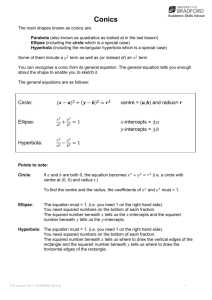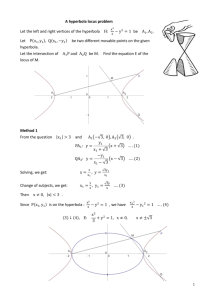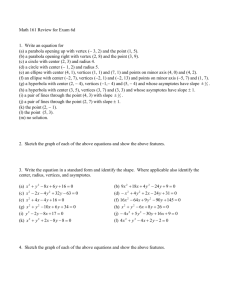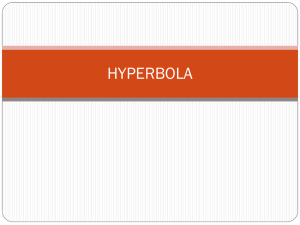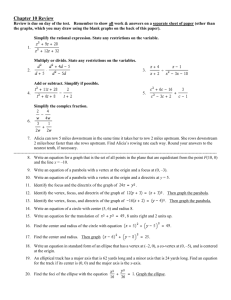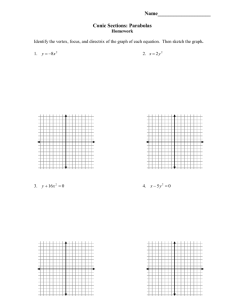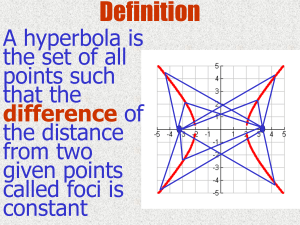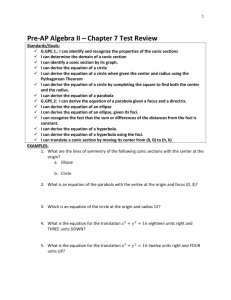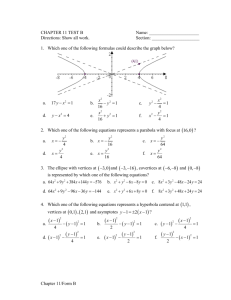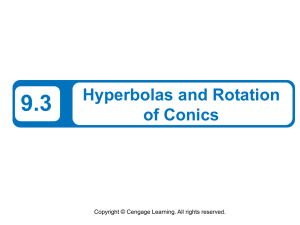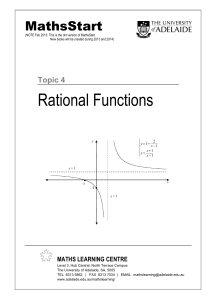conics summary
advertisement
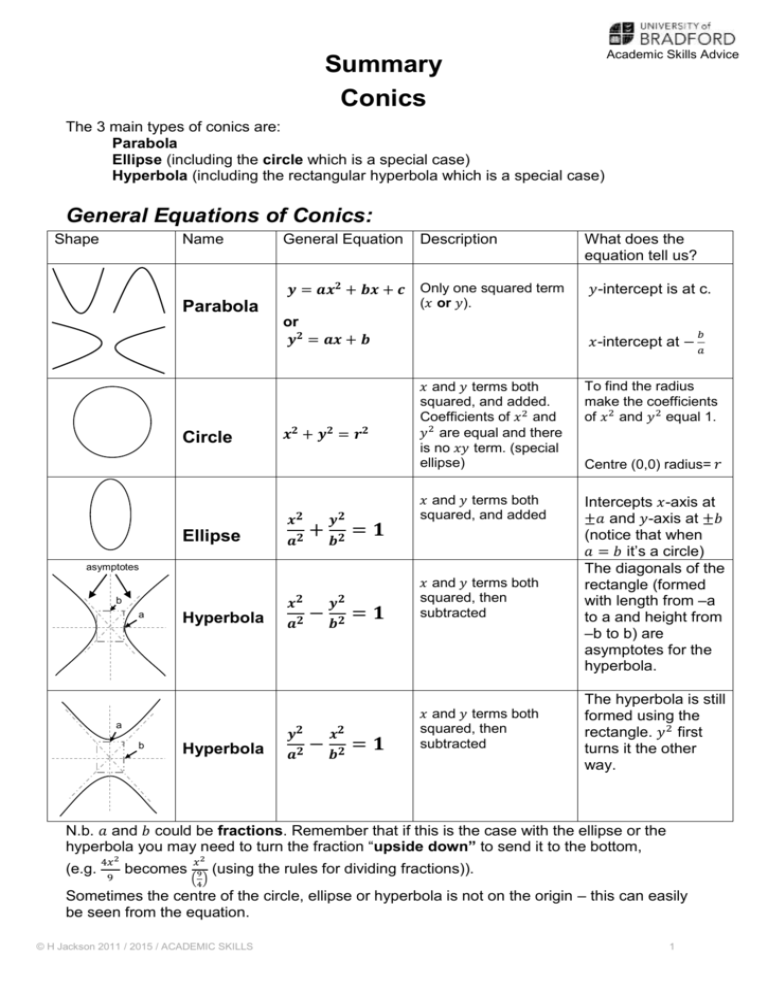
Academic Skills Advice Summary Conics The 3 main types of conics are: Parabola Ellipse (including the circle which is a special case) Hyperbola (including the rectangular hyperbola which is a special case) General Equations of Conics: Shape Name General Equation Description 𝒚 = 𝒂𝒙𝟐 + 𝒃𝒙 + 𝒄 Only one squared term or 𝒚𝟐 = 𝒂𝒙 + 𝒃 𝒙 𝟐 + 𝒚𝟐 = 𝒓 𝟐 𝒙𝟐 Ellipse 𝒂𝟐 + 𝒚𝟐 𝒃𝟐 =𝟏 𝑏 𝑥-intercept at − 𝑎 𝑥 and 𝑦 terms both squared, and added. Coefficients of 𝑥 2 and 𝑦 2 are equal and there is no 𝑥𝑦 term. (special ellipse) To find the radius make the coefficients of 𝑥 2 and 𝑦 2 equal 1. 𝑥 and 𝑦 terms both squared, and added Intercepts 𝑥-axis at ±𝑎 and 𝑦-axis at ±𝑏 (notice that when 𝑎 = 𝑏 it’s a circle) The diagonals of the rectangle (formed with length from –a to a and height from –b to b) are asymptotes for the hyperbola. asymptotes 𝒙𝟐 b a Hyperbola a b Hyperbola 𝑦-intercept is at c. (𝑥 or 𝑦). Parabola Circle What does the equation tell us? 𝒂𝟐 − 𝒚𝟐 𝒃𝟐 𝒚𝟐 𝒙𝟐 𝒂 𝒃𝟐 𝟐 − =𝟏 𝑥 and 𝑦 terms both squared, then subtracted =𝟏 𝑥 and 𝑦 terms both squared, then subtracted Centre (0,0) radius= 𝑟 The hyperbola is still formed using the rectangle. 𝑦 2 first turns it the other way. N.b. 𝑎 and 𝑏 could be fractions. Remember that if this is the case with the ellipse or the hyperbola you may need to turn the fraction “upside down” to send it to the bottom, (e.g. 4𝑥 2 9 becomes 𝑥2 9 4 ( ) (using the rules for dividing fractions)). Sometimes the centre of the circle, ellipse or hyperbola is not on the origin – this can easily be seen from the equation. © H Jackson 2011 / 2015 / ACADEMIC SKILLS 1 Equations of (translated) conics: Shape Name General Equation What does the equation tell us? (𝒙 − 𝒂)𝟐 + (𝒚 − 𝒃)𝟐 = 𝒓𝟐 Notice the extra 𝒂 and 𝒃. To find the centre and the radius make the coefficients of 𝑥 2 and 𝑦 2 equal 1. Circle Centre at (𝒂,𝒃) radius = 𝑟 Notice the extra 𝒙𝟎 and 𝒚𝟎 (𝒙−𝒙𝟎 )𝟐 Ellipse 𝒂𝟐 + (𝒚−𝒚𝟎 )𝟐 𝒃𝟐 Centre at (𝒙𝟎 , 𝒚𝟎 ) radius is 𝑎 along the 𝑥-axis and 𝑏 along the 𝑦-axis =𝟏 Notice the extra 𝒙𝟎 and 𝒚𝟎 asymptotes (𝒙−𝒙𝟎 )𝟐 2𝑎 Hyperbola 2𝑏 𝒂𝟐 − (𝒚−𝒚𝟎 )𝟐 Centre at (𝒙𝟎 , 𝒚𝟎 ) =𝟏 𝒃𝟐 The diagonals of the rectangle (with length 2𝑎 and height 2𝑏) are asymptotes for the hyperbola. N.b. The “rectangular hyperbola” is a special case where the asymptotes are perpendicular to each other (i.e. a=b, so a square is formed) Some equations may need rearranging to help decide on the type of conic they are. Examples: Starting Equation Rearrange We need the equation to =1 Conic Ellipse 9𝑥 2 + 4𝑦 2 = 36 𝒙𝟐 (÷ 36) 𝟒 + 𝒚𝟐 𝟗 Centre at (0,0) radius is 2 along the 𝑥-axis and 3 along the 𝑦-axis =𝟏 Complete the square for 𝑥 and 𝑦. 2 Circle 2 𝑥 − 6𝑥 + 𝑦 + 8𝑦 = −16 (𝑥 − 3)2 − 32 + (𝑦 + 4)2 − 42 = −16 𝟐 𝟐 (𝒙 − 𝟑) + (𝒚 + 𝟒) = 𝟗 𝑥 2 − 9𝑦 2 − 4𝑥 + 18𝑦 = 14 Complete the square and rearrange 𝑥 2 − 4𝑥 − 9(𝑦 2 − 2𝑦) = 14 (𝑥 − 2)2 − 4 − 9((𝑦 − 1)2 − 1) = 14 (𝑥 − 2)2 − 4 − 9(𝑦 − 1)2 + 9 = 14 (𝑥 − 2)2 − 9(𝑦 − 1)2 = 9 (÷ 9) © H Jackson 2011 / 2015 / ACADEMIC SKILLS (𝒙−𝟐)𝟐 𝟗 − (𝒚−𝟏)𝟐 𝟏 =𝟏 Centre at (3,-4) radius = 3 Hyperbola Centre at (2, −1) The diagonals of the rectangle (length -3 and +3 from the centre and height −1 and +1 from the centre) are asymptotes for the hyperbola. 2
